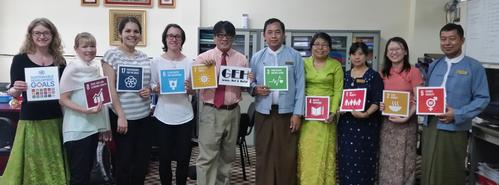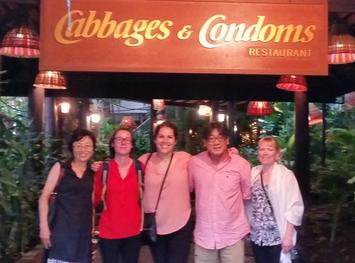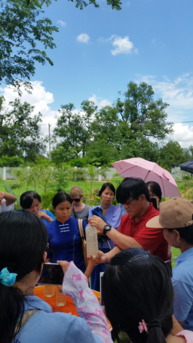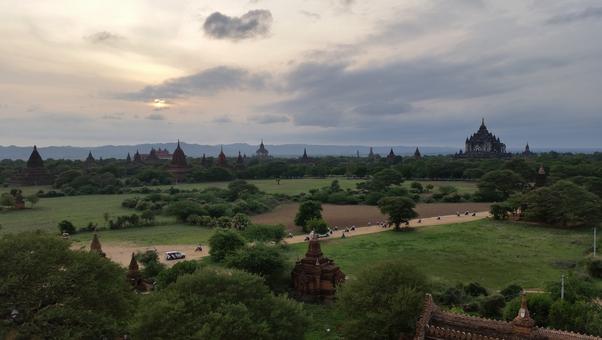By: Heidi West, MA, Co-founder & Director of Programs and Operations, Global Environmental Health LAB
I am writing on a bus between the cities of Mandalay and Yangon in Myanmar (AKA Burma). As we approach the last days of Global Environmental Health LAB’s (GEH LAB) 2016 summer program, I am pleased when reviewing what we have accomplished. We developed a robust public health research and capacity-building program while assembling an international team to work with local collaborators in Mandalay, Myanmar. All this was accomplished with a budget of less than $25,000 plus many volunteer hours.

In June 2016, with an international team of five members, we conducted 15 training workshops with hands-on research capacity-building activities that also included a joint epidemiological research project. Through these workshops we trained 75 faculty members and 83 students. An additional 150 people attended lectures and field activities covering such topics as research ethics, writing and publishing academic papers, risk assessment, the UN Sustainable Development Goals, survey research and building international collaborations.
During our time in Myanmar, the international team also laid the foundation for environmental public health research projects including risk assessments related to drinking water, solid waste and air pollution which will be continued in 2017’s follow-up program. We opened channels for sharing research results with the local government’s Mandalay City Development Committee. It was agreed GEH LAB would assist local officials in evidence-based decision making to increase the impact of the research and build new connections between the area’s academic institutions.
Using scientific research to guide decision making, our goal is to help the people of Myanmar to better survive, adapt and thrive in a rapidly changing world. We continue to work with local university partners at Yadanabon University, Mandalay University, University of Medicine Mandalay and Magway University on a research project that draws on complementary strengths and expertise.
GEH-LAB’s executive director, Tomoyuki Shibata, PhD, headed the 2016 team which included Maja Milkowska from Poland, who is working on two masters degrees in the Netherlands; Lizeth Galarza, a first-generation Mexican-American microbiologist and Kristin Ringstad a public-health nurse from British Columbia, Canada. Combining our diverse skills with the interests of faculty members at universities in Myanmar, GEH LAB set out on an ambitious program which is summed up by the following numbers:

2 staff members + 3 research scholars + 5 weeks in Myanmar + 7 research projects initiated + 8 countries represented
+ 20 team leads developed + 100 collaborators engaged
+ 300 participants educated + 2000 health surveys underway
= 1,000,000s potentially impacted!
This odyssey began in October 2015 when Dr. Shibata, who is an associate professor of public health at Northern Illinois University, DeKalb, and I met at the American Public Health Association’s annual meeting. We discussed our common interests and decided to work together to build the Global Environmental Health LAB (www.gehlab.org) into a not-for-profit organization. Its mission would be to increase the base of scientific knowledge for decisions made in public health policy and also to provide international research opportunities for a diverse range of students and professionals. We hope to help bridge the gap between the non-profit and academic sectors, while at the same time, improving public health and building the next generation of public health leaders.
Between the conference in Fall 2015 and our departure for South East Asia in May 2016, we worked to develop GEH LAB’s organizational foundation culminating with receiving our 501(c)(3) status as a not-for-profit research and educational organization. We expanded our partnerships with local collaborators in Myanmar and recruited an international team of students and young professionals.

Our 2016 program began in Bangkok, Thailand, where we met with Thai and Japanese colleagues and visited the Asian Institute of Technology, a leading international university in South East Asia. From there, the team traveled to Mandalay, Myanmar, to begin our research and capacity-building program to develop and strengthen the knowledge, skills, abilities, processes and resources of local universities and communities in Myanmar. We spent the final days of the program in the cities of Magway and Yangon working to expand our network of partners as well as the reach of the epidemiological survey sample.
United Nations’ Sustainable Development Goals
GEH LAB’s joint research project is entitled Community and Occupational Health Associated with Sustainable Development Goals (SDGs). Unanimously adopted by the UN General Assembly in fall 2015, the SDGs are an international initiative to improve lives and the environment worldwide by 2030 and build on the success of the Millennium Development Goals. This global development agenda and its associated targets, guide the project and provide a platform for connecting local and global efforts.

Our project took advantage of the expertise and interests of our international team. One of my own research areas, for example, is looking at the impact of migration on the health and well-being of migrants and their families. Many members of the international team plan to continue their GEH LAB research while pursuing PhDs in a variety of related fields. This action is another indicator of the program’s success, specifically designed to foster academic and professional development for international and local participants.
Myanmar: Selected as Site of GEH-LAB First International Program
I have always believed that the most powerful forces for change come from within; within ourselves, within our communities, within our connections. When I asked Dr. Shibata “why Myanmar?” His answer was simple, “we were asked,” he said.

Dr. Shibata met local partners in Myanmar through NIU’s Center for Burma Studies. These colleagues asked Dr. Shibata for a capacity-building program on public health and environmental health research. We knew we had the passion and desire to expand connections in South East Asia so we assessed what GEH LAB could provide, the knowledge and expertise of our local collaborators and the opportunities available to advance the academic and professional pursuits of our international team.
Focusing on the SDGs, Myanmar was an appropriate choice with 26 percent of its population living in poverty and a per capita income of only $702 annually (UNDP). Of utmost importance, Myanmar has one of the highest child mortality rates in the world. A baby born in Myanmar is seven times more likely to die by age five than a child born in the U.S. In 2016, adult life expectancy in Myanmar averages 65 years compared to 79 years the U.S (UNICEF).
According to UNICEF, most childhood deaths in Myanmar are due to preventable or treatable causes, such as diarrhea and acute respiratory illness. There is a lack of scientific evidence looking at the root causes of mortality, such as air pollution, water quality, sanitation and hygiene behavior. In addition, such critical factors as natural disasters and forced migration have not been widely researched. Finally, following turmoil in the education system after Myanmar’s universities were shut down by the government in 1988, the system has struggled to catch up and prepare its students and faculty to address these local and global challenges.

Myanmar’s History
Myanmar’s history goes back to the first millennium A.D. beginning with dynastic rule in Bagan (Pagan) in central Myanmar. In 1885, the British forcefully colonized Burma where it was ruled as part of British India until 1948 when Myanmar became an independent country. In 1962, a coup led to military rule with most of Myanmar’s years of independence experiencing ethnic strife and civil war.

Over the years, the United Nations and other international organizations reported systematic violations of human rights in Myanmar. In 2010, these abuses declined after a quasi-civilian government was elected. The country’s military junta was dissolved in 2011 and the Burmese Military has begun to relinquish government control.
Since releasing Nobel Peace Prize recipient, Aung San Suu Kyi from house arrest and releasing other political prisoners, Myanmar has improved its human rights record and its foreign relations. These gestures have led to the easing of trade and other economic sanctions. In a landmark 2015 election, Aung San Suu Kyi’s party, the National League for Democracy, won a majority in both houses and is working to lead the country on a path to true democracy.
Join the GEH LAB Team

GEH LAB promotes and supports safe and healthy communities on a local, regional and global scale. It accomplishes its mission by collaborating on public-health related research, promoting scientific engagement and working on community capacity building. GEH LAB is also helping to foster the next generation of public health leaders with international research activities involving students, scholars, professionals and communities throughout the world.
We are currently planning and recruiting for a follow-up program in Myanmar for early summer 2017. If you are a graduate student or professional looking to learn, contribute and engage in an impactful research based program, we encourage you to contact us for more information at admin@gehlab.org



